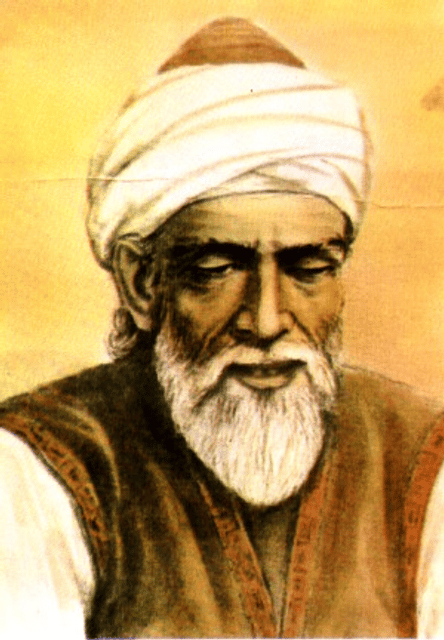Abu al-Wafa' Buzjani

Abu al-Wafa' Buzjani

Abu al-Wafa' al-Buzjani | |
|---|---|
| Born | June 10, 940 Buzhgan, Iran |
| Died | July 15, 998(998-07-15)(aged 58) |
| Residence | Baghdad |
| Academic background | |
| Influences | Al-Battani |
| Academic work | |
| Era | Islamic Golden Age |
| Main interests | Mathematics and Astronomy |
| Notable works | Almagest of Abū al-Wafā' |
| Notable ideas |
|
| Influenced | Al-Biruni, Abu Nasr Mansur |
Abū al-Wafāʾ, Muḥammad ibn Muḥammad ibn Yaḥyā ibn Ismāʿīl ibn al-ʿAbbās al-Būzjānī or Abū al-Wafā Būzhjānī (Persian: ابوالوفا بوزجانی or بوژگانی)[1] (10 June 940 – 15 July 998) was a Persian[2][3] mathematician and astronomer who worked in Baghdad. He made important innovations in spherical trigonometry, and his work on arithmetics for businessmen contains the first instance of using negative numbers in a medieval Islamic text.
He is also credited with compiling the tables of sines and tangents at 15 ' intervals. He also introduced the secant and cosecant functions, as well studied the interrelations between the six trigonometric lines associated with an arc.[4] His Almagest was widely read by medieval Arabic astronomers in the centuries after his death. He is known to have written several other books that have not survived.
Abu al-Wafa' al-Buzjani | |
|---|---|
| Born | June 10, 940 Buzhgan, Iran |
| Died | July 15, 998(998-07-15)(aged 58) |
| Residence | Baghdad |
| Academic background | |
| Influences | Al-Battani |
| Academic work | |
| Era | Islamic Golden Age |
| Main interests | Mathematics and Astronomy |
| Notable works | Almagest of Abū al-Wafā' |
| Notable ideas |
|
| Influenced | Al-Biruni, Abu Nasr Mansur |
Life
He was born in Buzhgan, (now Torbat-e Jam) in Khorasan (in today's Iran). At age 19, in 959 AD, he moved to Baghdad and remained there for the next forty years, and died there in 998.[4] He was a contemporary of the distinguished scientists Abū Sahl al-Qūhī and Al-Sijzi who were in Baghdad at the time and others like Abu Nasr ibn Iraq, Abu-Mahmud Khojandi, Kushyar ibn Labban and Al-Biruni.[5] In Baghdad, he received patronage by members of the Buyid court.[6]
Astronomy
Abu Al-Wafa' was the first to build a wall quadrant to observe the sky.[5] It has been suggested that he was influenced by the works of Al-Battani as the latter describes a quadrant instrument in his Kitāb az-Zīj.[5] His use of tangent helped to solve problems involving right-angled spherical triangles, and developed a new technique to calculate sine tables, allowing him to construct more accurate tables than his predecessors.[6]
In 997, he participated in an experiment to determine the difference in local time between his location and that of al-Biruni (who was living in Kath, now a part of Uzbekistan). The result was very close to present-day calculations, showing a difference of approximately 1 hour between the two longitudes. Abu al-Wafa is also known to have worked with Abū Sahl al-Qūhī, who was a famous maker of astronomical instruments.[6] While what is extant from his works lacks theoretical innovation, his observational data were used by many later astronomers, including al-Biruni.[6]
Almagest
Mathematics
He established several trigonometric identities such as sin(a ± b) in their modern form, where the Ancient Greek mathematicians had expressed the equivalent identities in terms of chords.[8]




He also discovered the law of sines for spherical triangles:

where A, B, C are the sides (measured in radians on the unit sphere) and a, b, c are the opposing angles.[8]
Some sources suggest that he introduced the tangent function, although other sources give the credit for this innovation to al-Marwazi.[8]
Works
Almagest (كتاب المجسطي Kitāb al-Majisṭī).
A book of zij called Zīj al‐wāḍiḥ (زيج الواضح), no longer extant.[6]
"A Book on Those Geometric Constructions Which Are Necessary for a Craftsman", (كتاب في ما یحتاج إليه الصانع من الأعمال الهندسية Kitāb fī mā yaḥtāj ilayh al-ṣāniʿ min al-aʿmāl al-handasiyya).[9] This text contains over one hundred geometric constructions, including for a regular heptagon, which have been reviewed and compared with other mathematical treatises. The legacy of this text in Latin Europe is still debated.[10][11]
"A Book on What Is Necessary from the Science of Arithmetic for Scribes and Businessmen", (كتاب في ما يحتاج إليه الكتاب والعمال من علم الحساب Kitāb fī mā yaḥtāj ilayh al-kuttāb wa’l-ʿummāl min ʾilm al-ḥisāb).[9] This is the first book where negative numbers have been used in the medieval Islamic texts.[6]
He also wrote translations and commentaries on the algebraic works of Diophantus, al-Khwārizmī, and Euclid's Elements.[6]
Legacy
The crater Abul Wáfa on the Moon is named after him.
On 10 June 2015, Google has changed its logo in memory of Abu al-Wafa' Buzjani.[12]